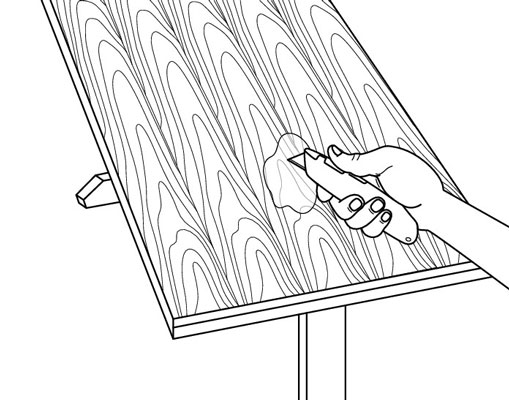You may be able to squash a veneer blister simply by placing a damp cloth over it, and then holding a hot iron on the cloth for a minute or so until the cloth starts getting dry. The heat and moisture sometimes reactivate the glue. It may be necessary, however, to do this several times.
Unlike veneer that lifts at the edges, a blister can occur anywhere on the surface, maybe even in the center of a table or chest. A blister tells you that the glue no longer bonds the veneer to the frame.
Be careful that you don’t keep a damp cloth on the surface too long without applying heat. Otherwise you may also have to repair a water mark.
To fix a blister that won’t respond to a damp cloth and hot iron, you have to create a little more damage to fix it. You need a single-edge razor blade or sharp utility knife, a knife with a long thin blade, white furniture glue, a damp soft cloth, and several books to use as weights. This is what you have to do:
With your single-edge razor blade or utility knife, slit the blister in half, going with the grain (fibers) in the veneer, not across it.

Don’t worry. The slit won’t be noticeable after you’ve repaired the piece.
Keeping one side flat, work the glue under the other side very carefully with a thin, long blade. The more flexible the blade is, the easier the job will be.
It’s easier to get glue to flow if thinned first with water. Also, syringes are now available for injecting glue in tight spots such as blisters. They work great.
Smear the glue around to coat the underside of the veneer as well as the frame of the furniture.
You can do that by pushing the blistered edge up and down firmly several times.
After gluing the first half, press it down.
Repeat Steps 2 through 4 on the other half of the veneer.
Press down hard on both edges to force excess glue out from under the veneer.
You can use a rolling pin, roller, or cold iron, but if you use an iron, protect it by placing some wax paper between the iron and the repair to avoid scratching the finish or getting the steam vents clogged.
Be sure to wipe away any excess glue that seeps out of the split. Use a damp cloth to wash it off the surface and then wipe it dry.
After you’re certain all the excess glue is gone, weight the blistered area with several old books until the glue has dried.

